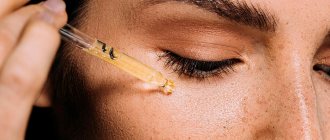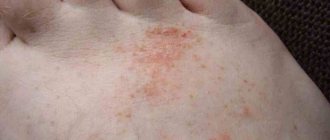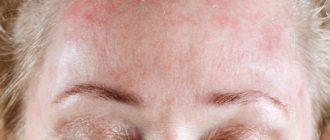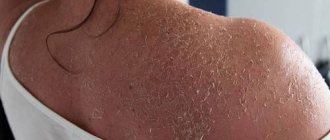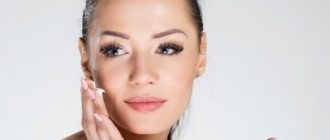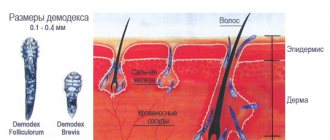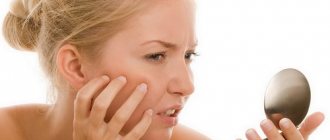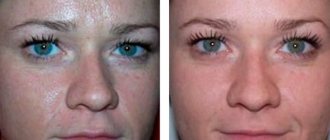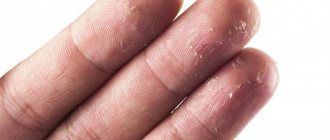The article will tell you about the causes of peeling, and also introduce you to popular methods for eliminating this problem.
Unfortunately, not all representatives of the fair sex have beautiful and healthy skin. Very often it begins to turn red and peel at the most inopportune moment.
And since women always want to look perfect, most girls begin to worry about this problem. But you shouldn’t be very upset, because if you take proper care of your face, then you will only read about peeling facial skin on the Internet.
Causes of peeling and redness of facial skin
Most often, unsightly red spots and peeling appear on the face in the autumn-winter period. This problem absolutely cannot be ignored. If you do not take adequate measures at the very beginning, then soon the skin will become very sensitive and begin to itch.
Reasons that cause peeling of facial skin: • Improper skin care • Prolonged exposure to cold • Frequent visits to the solarium • Vitamin deficiency • Lack of moisture in the skin • Allergy to cosmetics
Causes
The appearance of pathological reactions does not depend on skin type. Redness and peeling can appear on both oily and dry skin. Most often, deficiencies form during the demi-season periods. At this time, the likelihood of vitamin deficiency increases.
Unpleasant symptoms can also be a consequence of dehydration. To determine the causes of peeling, you need to consult a dermatologist.
The main factors that change the condition of the skin include:
- allergic reaction to cosmetic products;
- dehydration of the epidermis;
- tanning abuse;
- lack of vitamins;
- exposure to low temperatures;
- skin diseases;
- alcohol;
- hard water;
- insufficient air humidity;
- fungal infection.
In men, irritation is caused by improper shaving or incorrectly selected cosmetics. The appearance of rashes in a child is often caused by diathesis. The disease is the body's reaction to environmental irritants (food, cosmetic products, artificial fabrics, etc.). The tendency to diathesis has a genetic origin.
The most common cause of dry skin in women lies in improper facial care. In rare cases, pathology occurs as a result of hormonal imbalances. Peeling is considered a natural reaction to peeling and the use of cosmetics containing acids.
! Skin ailments accompanied by peeling include: demodicosis, seborrhea, mycosis, dermatitis and neurodermatitis.
Local location
Scaly rashes around the nose and forehead are characteristic of dermatitis. They can affect the scalp. In this case, the pathology is caused by an inflammatory process in the lower layers of the epidermis.
Redness on the cheeks most often occurs due to hypothermia or prolonged exposure to direct sunlight. They are temporary. Localization of rashes on the nose and chin indicates internal disorders. One of these is abnormalities in the functioning of the digestive system.
Face itches and flakes: diagnosis
Many people believe that redness and flaking will go away if you simply moisturize the skin.
Of course, such measures help some people, but there are cases when such rashes signal a disease of the internal organs. So: • If peeling of your facial skin began immediately after applying new cosmetics, then it is likely that you are having a banal allergic reaction. Try to stop wearing cosmetics for a while • The same symptoms can be caused by prolonged exposure to frosty air or exposure to direct sunlight. When going outside, always apply protective creams to your skin • But if problem areas begin to hurt, crack and become covered with eczema, then immediately seek advice from a specialist. Be sure to undergo a full examination, take all tests and do an ultrasound scan
Treatment of itchy skin
First of all, any cosmetologist will ask you to exclude from food all allergenic foods and other conditions that provoke itching (for example, a feather pillow or synthetic materials in clothing). In addition, you will need moisturizers: cosmetic ones, and you will also be recommended compresses from chamomile infusion. If these manipulations are useless, you should immediately use the services of a dermatologist, or even go to an allergist. What else will have to be done to establish a diagnosis:
- General urine test and general blood test;
- Biochemical blood test;
- Fecal analysis for helminths and occult blood;
- Skin scraping for fungus.
- Skin tests (to determine the nature of the allergy)
Based on the test results, after examination by a dermatologist, a diagnosis is made and treatment is determined. Taking into account the nature of the disease, either drug treatment or cosmetic procedures with a therapeutic focus are prescribed. Do not neglect the doctor’s advice, do not shirk the procedures, complete the full course of treatment, because the untreated allergy returns again and everything will have to start all over again.
Seborrhea
Indicators of this disease will be itchy skin, shine and flaking, and the appearance of pink spots.
It is treated using sodium thiosulfate, calcium chloride, corticosteroids, ointments and creams of antibacterial composition (bicarbonate, sulfur solution), salicylic alcohol, boric acid, as well as hawthorn tincture and lily of the valley tincture are used).
Psoriasis
You should think about psoriasis if the skin itches, becomes red, and becomes covered with flaky skin flakes.
Treatment is carried out using salicylic acid, sulfur-tar and naphthalan ointments, calcipotriol, diprosalic. Phototherapy, homeopathic remedies, icitretin, roaccutane, and cyclosporine have been successfully used.
Demodicosis
With this disease, severe itching occurs, eyelashes fall out, and the face becomes covered with acne.
First of all, with the help of drugs, they strengthen the immune system (in order to strengthen the body’s resistance) and try to ensure the normal functioning of the stomach and intestines. Antiparasitic drugs are prescribed in the complex: trichopolum, tinidazole, metronidazole. Ointments (sulfur, yellow mercury, ichthyol), pharmaceutical “talkers”, ointments of antibacterial compositions “Aversect”, “Permethrin” are used externally. To reduce inflammation, use Dexrdem Phyto cream-gel, which has a good anti-inflammatory effect.
Rosacea
The symptoms of this disease are lumpy, inflamed skin. The skin constantly itches, turns red, and the spider veins become very noticeable.
It is treated with metronidazole in ointments and tablets, a certain diet is prescribed, lotions are made with boric acid, and a special massage is prescribed. Rosacea is treated with antibiotics, immunocorrective medications, cold treatment and psychocorrection.
Diet and nutrition for peeling and redness of facial skin
If you follow all the dermatologist's advice, but your skin still does not return to normal, then try adjusting your diet. Very often it is unbalanced, unhealthy food that has the most negative effect on the skin. Recommendations for proper nutrition: • Avoid salty, spicy and smoked foods • Eat as little sweets as possible • Include nuts, avocados and olive oil in your diet • Do not drink too much strong tea and coffee
Causes of itching
There may be several reasons for this condition. The most common factors that cause itching and redness of the facial skin are dermatological diseases (dermatitis, psoriasis, mild ichthyosis).
Physical reasons
Often the causes of skin irritation can be heat, or vice versa - low temperature, for example, cold wind, high humidity or dry air.
This is due to the fact that the epidermis contains a large number of nerve endings that are sensitive to cold and thermal changes.
Ultraviolet radiation (natural and artificial) with prolonged exposure provokes burns. A person feels as if the skin is on fire, it turns red, and after a while it begins to itch and peel.
Atopic dermatitis
Atopic dermatitis is a manifestation of an allergic reaction.
Its main symptoms are:
- constant itching with redness, which can also appear on the body;
- dryness;
- peeling.
If the rash is scratched, ulcers may form and the face may swell.
Dermatitis is one of the reasons why the face itches. This pathological process can also affect the upper and lower extremities, the torso, however, the most common localization is the eyelids, cheeks and lips.
Mental causes of skin redness
Multiple stresses that often accompany a modern person, emotional instability and a tendency towards depressive disorder can lead to itching, burning and redness on the face.
This is unpleasant not only from a cosmetic point of view. Staying in this state for a long time, a person can undermine his immune system and, thereby, provoke the appearance of eczema and psoriasis.
Psoriasis
Psoriasis is a chronic inflammatory disease. Previously it was believed that psoriasis does not affect the face, but only the limbs, but recent studies have refuted this statement.
The symptoms are:
- itchy redness, as a manifestation of mild inflammation;
- in the worst case, painful, reddened, very itchy plaques;
- peeling.
Most often, psoriasis appears on the forehead, eyebrows and the space between the upper lip and nose.
Vascular diseases
Vegetative-vascular dystonia reduces the tone of skin vessels, which cannot narrow and, as a result, expand. On the chin, cheeks and forehead this manifests itself as redness and itching. All this indicates instability of the nervous system and problems with the autonomic system.
Eczema
Eczema is an inflammatory disease that occurs as a result of exposure to stress and allergic factors. Initially, it manifests itself as irritation on the skin of the face, with the skin constantly itching.
Next, the affected areas turn into blisters, which enlarge and burst over time. Erosion occurs, from which fluid is constantly released. Then scarring occurs, which leads to a cosmetic defect - scars.
Hives
Urticaria is a manifestation of an allergic reaction in the form of a rash that periodically appears and disappears. Acute urticaria occurs as a result of exposure to allergic substances. Redness and itching can occur on any part of the skin, including the face.
You may have a fever and headache. This condition disrupts a person’s sleep for a long time and causes psycho-emotional disorders.
Redness of the skin due to diseases of internal organs
Often problems with internal organs are reflected on the skin.
Some diseases can cause itching and redness on the face:
- Anemic conditions;
- Diabetes;
- Infectious and inflammatory processes;
- Nervous system disorder;
- Kidney diseases;
- Diseases of the gastrointestinal tract.
Seborrhea
When the functional ability of the sebaceous glands is impaired, seborrhea occurs, which is manifested by severe redness and multiple pimples.
Seborrheic dermatitis affects:
- forehead skin;
- eyebrows;
- wings of the nose;
- space above the upper lip.
However, the favorite localization of seborrhea is the scalp.
Vitamins for peeling and redness of the skin on the face
Try to eat fresh vegetables and fruits every day. They will gently and, most importantly, correctly normalize the condition of the skin from the inside. During the cold season, you can saturate your body with the necessary microelements using vitamin complexes or prepare food from certain products. Vitamins beneficial for the skin: • Antioxidants. Rejuvenate the skin and make it more elastic • Vitamin A. Promotes the formation of new healthy cells • Vitamin E. Responsible for the amount of moisture • Zinc. Stimulates collagen production • Selenium . Helps skin recover faster
Preparations for peeling and redness of the skin on the face
If you want to forget about peeling facial skin as quickly as possible, then in addition to traditional methods, try using pharmaceutical products that contain the substance dexapanthenol . Typically, such drugs are sold in the form of sprays or creams. Bepanten cream is also very good at eliminating peeling facial skin. It gently relieves irritation and promotes rapid restoration of the epidermis. It can be used to both treat skin problems and prevent red spots. Method of treatment : • Treat problem areas with the substance. The spray can be simply sprayed, and the cream should be applied to the affected areas using a cotton swab or simply with clean hands • Do a light patting massage • Wait 10-15 minutes and carefully remove the remaining drug • Repeat the procedure at least three times a day
Varieties
The nature of the burning sensation depends on the nature of its origin. There are two large archetypes, which include smaller species:
- Physiological type (irritation from external factors):
- burns (solar, chemical, thermal);
- a bite of an insect;
- prolonged friction of the skin, for example, on rough clothing;
- reaction to dry, warm air;
- abrasions, bruises, bruises;
- Pathological type (changes in mentality or condition)
- mental instability;
- changes in physiological state (pregnancy, old age);
- depression;
- feeling of psychological discomfort;
- stress.
Often the symptoms of a mixed type of burning appear, where both signs of a pathological disorder and physiological ones can manifest themselves.
Peeling and redness of the skin on the face: care and prevention
Absolutely all women strive to preserve the youth of their skin, because it is its appearance that can tell about the age of the fair sex. And changes such as red spots and peeling will significantly reduce the self-esteem of any person. Proper prevention and timely skin care will help you avoid such troubles.
Tips to prevent redness and flaking: • Avoid using antibacterial soap. Most often, it kills not only harmful microflora. • Take care of your skin with oil-based cleansers. Excess of such products should be removed with a soft towel or cotton swab • While in the sun, periodically treat your face with thermal water spray. This will help maintain the required amount of moisture in the epidermis • In winter, do not go outside without a protective cream. To achieve the desired effect, the product must be applied half an hour before going out. • After water procedures, be sure to wipe your face with a special tonic. Also, do not forget to apply moisturizer • Choose cosmetics that do not contain alcohol or lanolin. These two substances dehydrate the skin and provoke allergic reactions • Drink as much fluid as possible and saturate your body with vitamins. Water should be drunk in its pure form, and vitamins, in season, can be obtained from fresh products
Causes of redness on the face
The reasons why the skin may peel are: external and internal. But such a symptom occurs due to the death of the old layer of the epidermis. The first type of factors that provoke dry skin are caused by various changes that affect a person externally.
The second type is directly related to problems occurring in the patient’s body.
External reasons
External factors that cause dry skin:
- insufficient care;
- use of low-quality cosmetics;
- weather changes (wind, sun);
- recent facial cleansing.
Most often, peeling appears in the winter season, due to sudden changes in temperature, so cosmetologists recommend applying a protective cream to your face before going outside.
If the cause of peeling is recent cleaning, then there is no need to take any treatment measures; you need to wait and the dryness will go away on its own. This does not happen to every person. But if the skin was not ready for such a procedure, then scales may appear 3-4 days after it.
- Mechanical damage to the skin may cause irritation. Often it begins to dry out and peel due to prolonged wear of a scarf or high-top sweater, which constantly rubs.
- Whatever the reason for this phenomenon, it indicates that the body does not have enough vitamins, moisture, or care.
Internal reasons
The internal causes of peeling skin are very difficult to identify, as a full comprehensive examination is necessary. To understand the factors causing such a symptom, it is recommended to consult an endocrinologist and get tested for hubbub. If diseases of the internal organs are confirmed, the doctor will prescribe treatment. Often a factor in the occurrence of symptoms is poor nutrition.
The skin of a woman's face may itch and peel due to changes in hormonal levels. The reasons for its development include the following conditions:
- menopause;
- pregnancy;
- menstruation.
An allergic reaction is another reason for the appearance of peeling of the epithelium. But with this disease other symptoms appear:
- itching,
- burning,
- sneezing,
- cough.
Other diseases that provoke peeling include the following:
- Diathesis. This disease occurs due to an allergic reaction to food or medications. Distinctive symptoms of the disease: redness and dry skin.
- Dermatitis. Women with oily skin are often susceptible to this disease. There are many reasons for its appearance: stress, decreased immunity, heredity, improper care, poor nutrition.
- Mycosis. This is a fungal disease that, if not treated promptly, leads to the formation of ulcers.
- Psoriasis. The disease is an autoimmune disease, and therefore it is difficult to identify the causes of its occurrence. They may be similar to dermatitis.
- Ichthyosis. This is a hereditary disease, the distinctive symptoms of which are itching, flaking and the appearance of a gray complexion. In order not to provoke dermatitis, you need to stop using soap and start treatment.
Face masks for peeling skin
Masks are considered a fairly effective method for treating skin problems. And, perhaps, the most important advantage of this method is that it is quite easy to prepare useful products at home. If you do everything correctly, then in just a few procedures your skin will delight you with its appearance.
There are three types of masks: • Cleansing. Gently removes the dead layer of the epidermis and promotes the growth of new cells • Nourishing . Saturates the skin with beneficial vitamins and microelements • Moisturizing. Moisturizes the skin and promotes healing and renewal
How to choose a cream for peeling skin
Since you need more than just a cosmetic product, the cream you choose should not only moisturize and nourish, but also soften the skin, heal wounds and promote recovery. A properly selected product will restore the condition of the skin and make the face more fresh and toned. Components that must be included in the cream: • Hyaluronic acid • Panthenol • Vegetable oils • Fruit acids • Beeswax • Vitamins and natural extracts
Peeling skin: tips and reviews
Of course, no cosmetologist will give a 100% guarantee that the product he prescribed will help you get rid of peeling facial skin forever. Since each organism has its own characteristics, the method that quickly helps one person may not be suitable for another. Cosmetic procedures that effectively relieve skin problems: • Mesotherapy • Peeling using fruit acids • Biorevitalization • Intensive moisturizing
Maryana: I struggled with red spots on my face for a very long time. I tried everything possible, but I only got results after I made a couple of nourishing masks. Now I no longer wait for problems to appear, but several times a week I pamper my face with useful masks.
Violetta: My skin problems appeared just before the wedding, so I didn’t conduct any experiments and immediately turned to a cosmetologist.
He advised me to give up certain foods and cosmetics. Just a few days later I saw an improvement.
What are red spots on the face?
Red spots appear on various parts of the facial skin. By assessing the location, type and additional symptoms, a preliminary diagnosis can be made.
Localization
In some diseases, red spots are localized in certain areas:
- nose - allergies, infectious diseases, demodicosis, fungal diseases, rosacea, lupus erythematosus, stress, hormonal imbalance and others;
- chin - allergies, rosacea, scleroderma (connective tissue disease), irritation, hormonal imbalance and others;
- cheeks - allergies, rosacea, rosacea, lupus erythematosus, infectious diseases, elevated body temperature, smoking, alcohol consumption, poor diet, diseases of the vascular system and others;
- forehead - seborrhea, allergies, red versicolor, irritation, rosacea and others;
- area around the eyes - irritation, inflammatory diseases of the eye sockets, kidney disease, fatigue, hypertension and others;
- near the mouth - allergies, helminthiasis, gastrointestinal diseases, fungus, infectious diseases, herpes and others.
Appearance: Spots may peel or become wet
In some diseases, red spots can form on any part of the face and even spread throughout the skin. Therefore, it is necessary to take into account the appearance of the stains.
- dryness, peeling, tightness - allergic reaction, dehydration, chapping, burn;
- weeping spots - eczema, dermatitis;
- raised spots - subcutaneous acne, vitamin deficiency, infectious diseases, fungi;
- swelling - inflammation, ripening pimple;
- swelling - kidney disease, allergies, diathesis;
- pus - inflammation, purulent pimples, severe form of fungus.
Symptoms
The appearance of red spots can be accompanied by a number of unpleasant signs. Most often there is a burning sensation, itching or pain. In addition, the spots may itch and peel.
However, you should not give in to temptation and scratch them, since damage to the skin can aggravate the situation. The listed signs often indicate the presence of skin diseases. A feeling like your face is on fire indicates high blood pressure.
Nature of manifestation of irritation
Red spots can be acute or chronic, depending on the cause. In the presence of chronic diseases, red spots appear periodically or do not leave the skin.
Temporary redness goes away after a few days or weeks and usually does not return.
